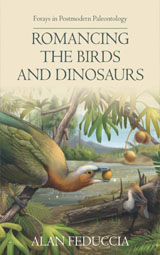Birds and dinosaurs have dominated human interest for decades. In this well-supported revolutionary view of the field, critical questions are explored with credible evidence and biological thought. Are birds derived directly from advanced dinosaurs, or are they closely related dinosaur cousins? Did flight originate via the natural "gravity-assisted" trees-down model, or from the improbable “gravity-resisted” ground-up model? Were the earliest birds ground-predators or trunk-climbing gliders? Were dinosaurs hot-blooded with insulating protofeathers, or highly active, cold-blooded reptiles? These are among the questions addressed in this path-breaking book.
Current consensus suggests that early birds were earth-bound and flight began on the ground. Reversing that logic, since birds are hot-blooded, by inference so too were dinosaurs, and extraordinarily complex feathers, flight brain and inner ear, evolved before flight in dinosaurs. The iconic early bird Archaeopteryx, despite innumerable flight and arboreal features, is now displayed as an earth-bound predator that could not fly. In reality, we have yet to provide satisfactory explanations for much of the biological origin and early evolution of birds. Among the questions addressed is whether truly feathered dinosaurs are in reality lost or "hidden birds?" The architectural complexity of feathers leads the author to the conclusion that if an animal has evolved extraordinarily complex, aerodynamically-designed feathers, an avian flight hand, flight membranes, and a flight brain, it's a bird.
Birds and dinosaurs captivate and enchant the human imagination. These intriguing animals have dominated the field of paleontology and evolution for the past half century, engendering heated debate on avian ancestry, the origin of flight and feathers, and the biology of their fossils. Are birds living dinosaurs? In this series of entertainingly contentious and captivating essays evolutionary biologist Alan Feduccia writes with verve and humor to expose major problems in the field and advocate liberation from the shackles of consensus thinking about birds and dinosaurs. He maintains that the euphoria of paleontologists claiming to have solved the major problems of bird evolution is premature, largely generated by the adoption of a rigid, cult-like methodology, heavily blended with ideology, and excluding many biological and geological principles. He adroitly exposes and elucidates major mistakes in the field and their aftermath.
Romancing the Birds and Dinosaurs is a lucid revelation of clarity and synthesis, a fascinating unveiling of the underlying science that has produced the good, but also often appalling fossil research and wild speculation in bird and dinosaur evolution. A must read for anyone interested in this rapidly evolving field, the short, concise and incisive essays provide the reader with access to this complex topic.











